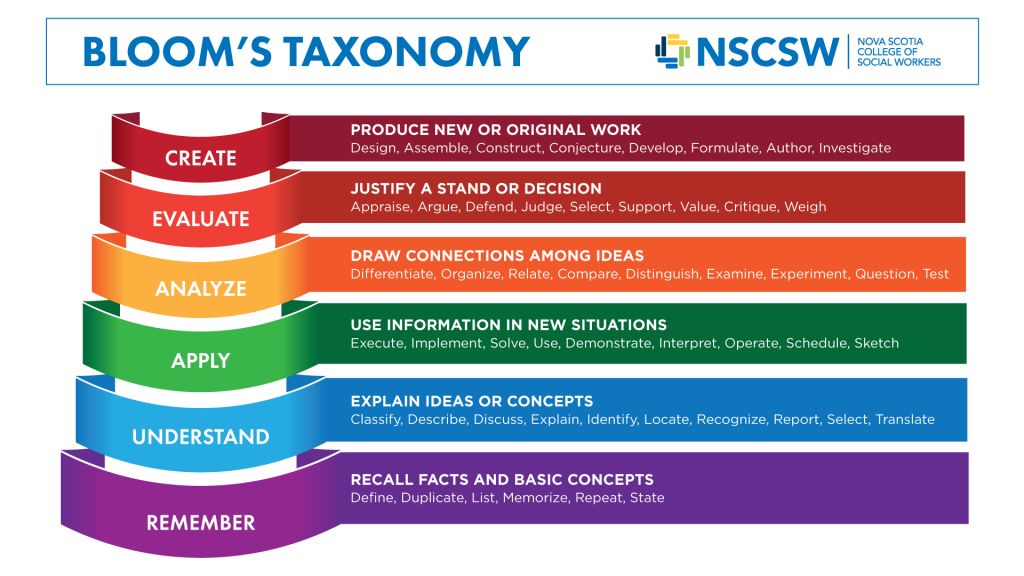
Learning Module for support on writing clear achievable learning objectives.
Developing Learning Objectives
A learning objective is a statement of the intended general goal a candidate wishes to complete by the end of program. It is a statement describing a performance capability to be acquired by the candidate. Well-written learning outcomes are concise and clearly stated, specific enough to be observable and measurable and thus capable of being assessed. They are broad enough so as not to limit flexibility in achieving them and they are realistic given available time and resources.
A good outcome is SMART: Specific, Measurable, Achievable, Realistic, Time-bound.
- Specific: Make learning objectives as specific, focused, and clear as possible – general outcomes will be hard to measure! They should indicate a clear action.
- Measurable or observable: Learning objectives should be written in terms of observable, behavioral outcomes. Include features that will help you know whether the objective has been achieved.
- Achievable: Make sure they are achievable within the time-span of the Candidacy mentoring program.
- Realistic: Should be supported by the appropriate tools and resources.
- Time-bound: They should specify a timeframe for action.
- Action verb(s)
- Subject
- Context
The ideal learning outcome has three elements:
Objectives (learning goals) are important to establish in a pedagogical interchange so that mentors and candidates alike understand the purpose of that interchange of knowledge. Candidates can benefit from using frameworks to organize objectives because organizing helps to clarify objectives for themselves and for mentors. Having an organized set of objectives helps mentors to:
- Plan and deliver appropriate activities;
- Design valid assessment tasks and strategies; and “ensure that instruction and assessment are aligned with the objectives.
Bloom’s taxonomy is a useful tool for creating dynamism within your learning objectives. These “action words” describe the cognitive processes by which thinkers encounter and work with knowledge

- Brainstorm what are the most important things you want to
know, be able to do, or value after completing the Candidacy Mentorship Program? Begin each objective with an action verb, which are verbs that result in overt behaviour or products that can be observed and measured. Bloom's Taxonomy of Educational Objectives (above) provides some useful verbs to write objectives for different levels of learning.
Avoid verbs that are unclear and cannot be observed and measured easily, for example: appreciate, become aware of, become familiar with, know, learn, and understand.
- The action verb is followed by the subject of the learning and context in which the learning occurs.
- Clearly link each learning objective to one or more relevant sections of the Standards of Practice and/or the Code of Ethics.
- Continue to draft a list of possible learning objectives. Be realistic in considering what is possible to complete.
- Identify the limits to confidentiality, self-determination, and informed consent within my field of practice in relation to the rights of others. (Understand)
- Demonstrate cultural humility in relation to my areas of practice and the populations served. (Apply)
- Examine the tensions between confidentiality, self-determination, informed consent, the rights of society, and the capacity of clients in my area of practice. (Analyze)
These learning objectives link to:
- Standard 1: Confidentiality, Self-Determination & Informed Consent
- Code Value 1: Respect for the Inherent Dignity and Worth of Persons
- Code Value 5: Confidentiality in Professional Practice
- Define how I distinguish actions and statements made as a private citizen and actions and statements made as a social worker, and the impact of both for my practice. (Remember)
- Critique issues related to the professional regulation of social work such as ethics standards and the professional conduct process. (Evaluate)
- Formulate a personal framework for on-going sustainable self-care. (Create)
These learning objectives link to:
- Standard 10: Protection of the Public
- Code Value 4: Integrity of Professional Practice
- Code Value 6: Competence in Professional Practice
- Is the learning objective SMART?
- Is the learning objective learner-centered?
- Does the learning objective use an effective action verb that targets the desired level of performance?
- Do the learning objectives measure a range of educational objectives?
- Does each learning objective clearly link to specific parts of the Standards of Practice and/or the Code of Ethics?
